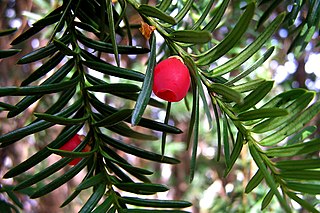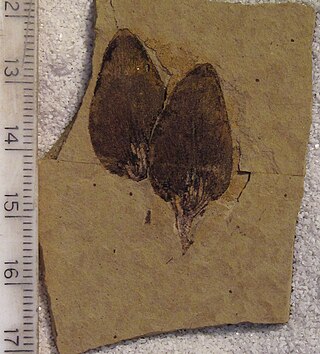
Taxaceae, commonly called the yew family, is a coniferous family which includes six extant and two extinct genera, and about 30 species of plants, or in older interpretations three genera and 7 to 12 species.

Torreya is a genus of conifers comprising six or seven species placed in the family Taxaceae, though sometimes formerly placed in Cephalotaxaceae. Four species are native to eastern Asia; the other two are native to North America. They are small to medium-sized evergreen trees reaching 5–20 m, rarely 25 m, tall. Common names include nutmeg yew.
Paleontology or palaeontology is the study of prehistoric life forms on Earth through the examination of plant and animal fossils. This includes the study of body fossils, tracks (ichnites), burrows, cast-off parts, fossilised feces (coprolites), palynomorphs and chemical residues. Because humans have encountered fossils for millennia, paleontology has a long history both before and after becoming formalized as a science. This article records significant discoveries and events related to paleontology that occurred or were published in the year 1954.
Paleontology or palaeontology is the study of prehistoric life forms on Earth through the examination of plant and animal fossils. This includes the study of body fossils, tracks (ichnites), burrows, cast-off parts, fossilised feces (coprolites), palynomorphs and chemical residues. Because humans have encountered fossils for millennia, paleontology has a long history both before and after becoming formalized as a science. This article records significant discoveries and events related to paleontology that occurred or were published in the year 1940.
Paleontology or palaeontology is the study of prehistoric life forms on Earth through the examination of plant and animal fossils. This includes the study of body fossils, tracks (ichnites), burrows, cast-off parts, fossilised feces (coprolites), palynomorphs and chemical residues. Because humans have encountered fossils for millennia, paleontology has a long history both before and after becoming formalized as a science. This article records significant discoveries and events related to paleontology that occurred or were published in the year 1933.

Abies milleri, an extinct species of fir known from fossil remains found in deposits from the early Eocene Ypresian stage in Washington State, USA, is the oldest confirmed record for the fir genus.
Acer clarnoense is an extinct maple species in the family Sapindaceae described from a series of isolated fossil leaves and samaras. The species is known from the late Eocene sediments exposed in the state of Oregon in the US. It is one of several extinct species placed in the living section Macrantha.
Torreya clarnensis is an extinct species of conifer in the yew family Taxaceae solely known from the middle Eocene sediments exposed in north central Oregon. The species was first described from a series of isolated fossil seeds in chert.
Diploporus is an extinct genus of conifers in the yew family Taxaceae, containing the single species Diploporus torreyoides known from the middle Eocene of north central Oregon and the Late Paleocene of south central North Dakota. The species was first described from a series of isolated fossil seeds in chert.
Actinidia oregonensis is an extinct species of flowering plants in the kiwifruit family, Actinidiaceae, solely known from the middle Eocene sediments exposed in north-central Oregon. The species was first described from a series of isolated fossil seeds in chert.
Rhus rooseae is an extinct species of flowering plants in the sumac family, Anacardiaceae, solely known from the middle Eocene sediments exposed in north central Oregon. The species was first described from a series of isolated fossil seeds in chert.
Paleopanax is an extinct genus of flowering plant in the Ginseng and Ivy family, Araliaceae, containing the single species Paleopanax oregonensis. The species is solely known from the middle Eocene sediments exposed in north central Oregon and was first described from a series of isolated fossil fruits in siltstones.

Coryloides is an extinct genus of flowering plants in the hazelnut family, Betulaceae, containing the single species Coryloides hancockii. The species is solely known from the middle Eocene sediments exposed in north central Oregon and was first described from a series of isolated fossil nuts in cherts.
Kardiasperma is an extinct genus of flowering plants in the hazelnut family, Betulaceae, containing the single species Kardiasperma parvum. The species is solely known from the middle Eocene sediments exposed in north central Oregon and was first described from a series of isolated fossil nuts in cherts.
Cornus clarnensis is an extinct species of flowering plant in the dogwood family, Cornaceae, solely known from the middle Eocene sediments exposed in north central Oregon. The species was first described from a series of isolated fossil seeds in chert.

Langeria is an extinct genus of flowering plants in the family Platanaceae containing the solitary species Langeria magnifica. Langeria is known from fossil leaves found in the early Eocene deposits of northern Washington state, United States and similar aged formations in British Columbia, Canada.
Nyssa spatulata is an extinct species of flowering plant in the tupelo family, Nyssaceae known from the middle Eocene sediments exposed in north central Oregon. The species was first described from a series of isolated fossil seeds in chert.
Paraconcavistylon is an extinct genus of flowering plant in the family Trochodendraceae comprises a single species, Paraconcavistylon wehrii. The genus is known from fossil fruits and leaves found in the early Eocene deposits of northern Washington state, United States, and southern British Columbia, Canada. The species was initially described as a member of the related extinct genus Concavistylon as "Concavistylon" wehrii, but subsequently moved to the new genus Paraconcavistylon in 2020 after additional study.

Pseudolarix wehrii is an extinct species of golden larch in the pine family (Pinaceae). The species is known from early Eocene fossils of northern Washington state, United States, and southern British Columbia, Canada, along with late Eocene mummified fossils found in the Qikiqtaaluk Region, Nunavut, Canada.

Pteronepelys, sometimes known as the winged stranger, is an extinct genus of flowering plant of uncertain affinities, which contains the one species, Pteronepelys wehrii. It is known from isolated fossil seeds found in middle Eocene sediments exposed in north central Oregon and Ypresian-age fossils found in Washington, US.






